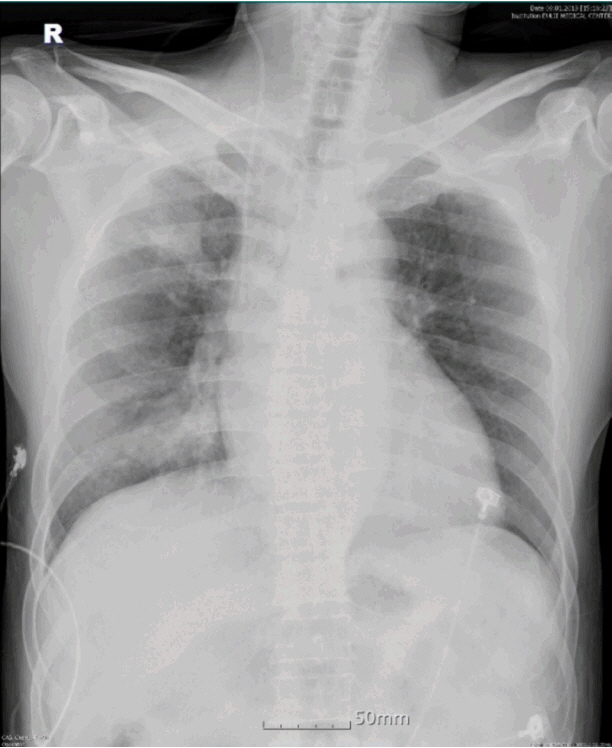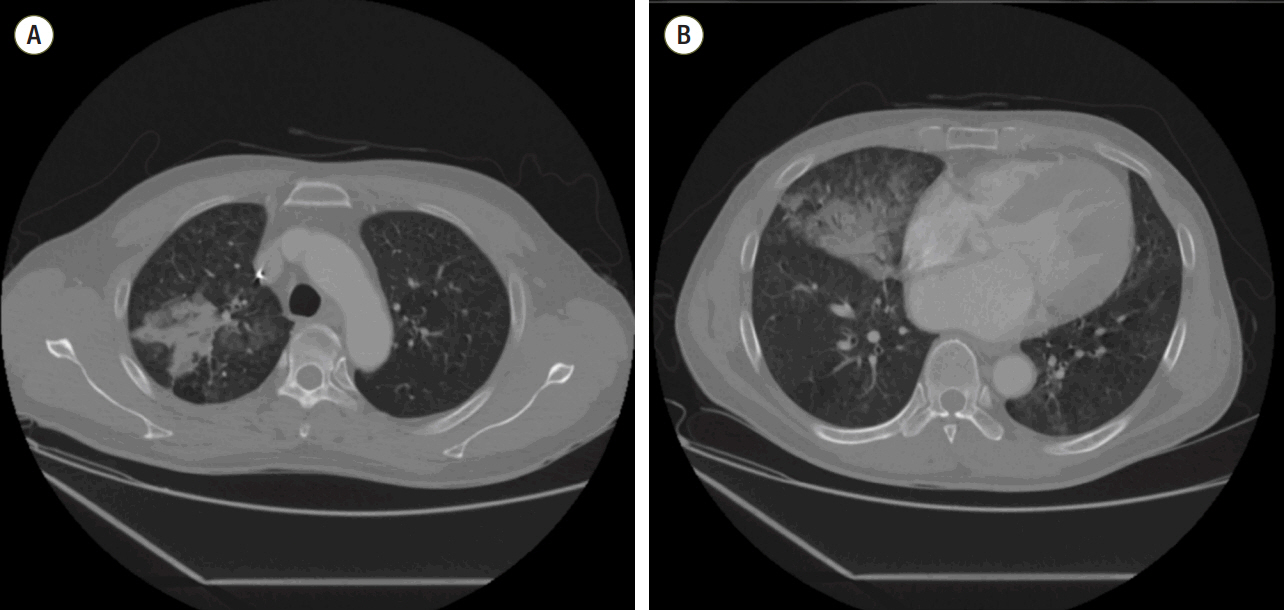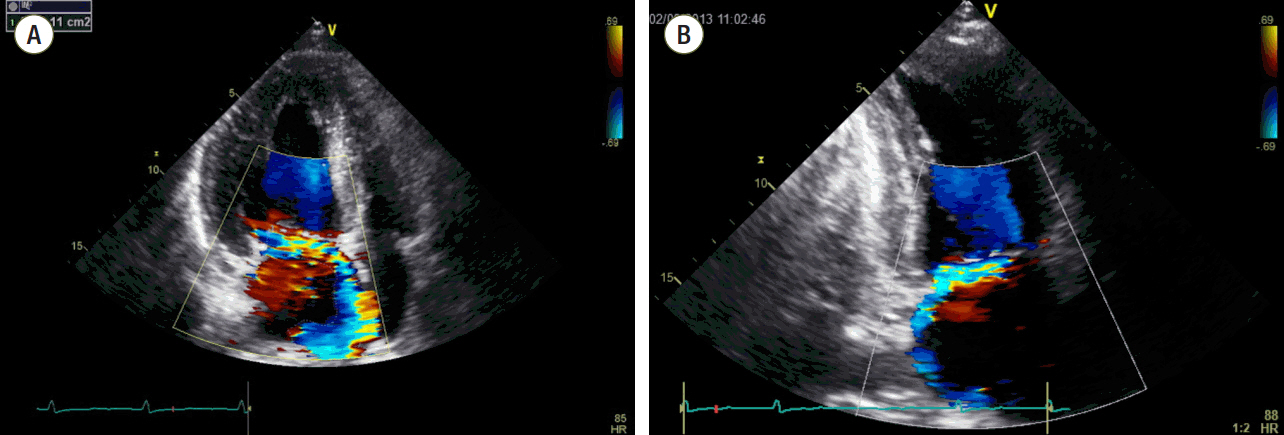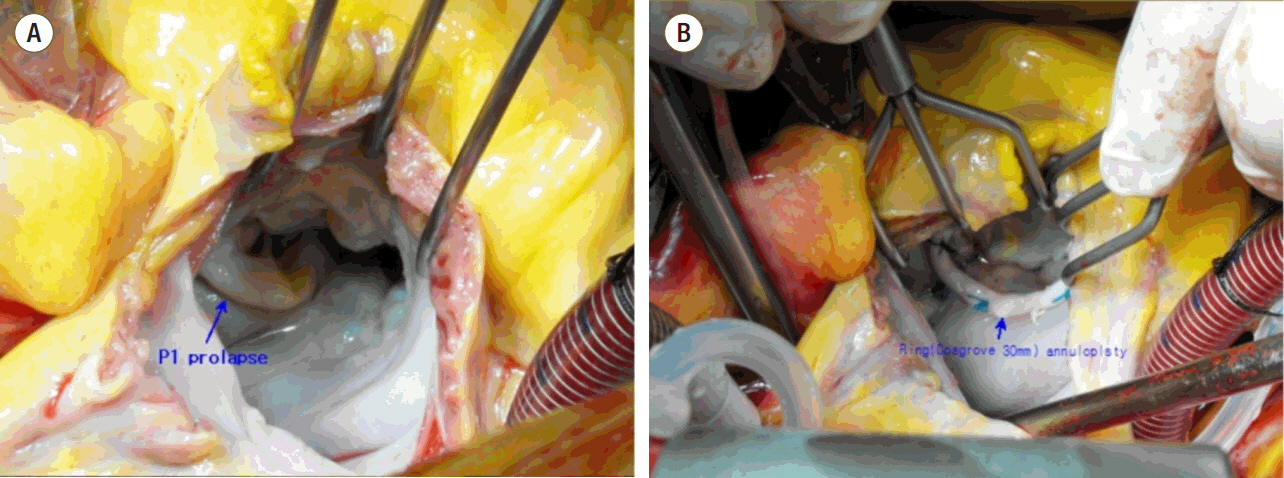Korean J Crit Care Med.
2015 Aug;30(3):202-206. 10.4266/kjccm.2015.30.3.202.
Massive Hemoptysis due to Acute Mitral Regurgitation with Sporadic Primary Mitral Valve Prolapse
- Affiliations
-
- 1Division of Pulmonology and Allergy, Department of Internal Medicine, Eulji General Hospital, Seoul, Korea. hoonakr@eulji.ac.kr
- KMID: 2227650
- DOI: http://doi.org/10.4266/kjccm.2015.30.3.202
Abstract
- The most common cardiac cause of massive hemoptysis is mitral stenosis. Mitral regurgitation is rarely complicated by massive hemoptysis. A 48-year-old man with no significant medical history was admitted to our hospital with hemoptysis and production of 500 mL of blood within 24 hours. A pan-systolic murmur was found on chest examination. A chest computed tomography showed airspace consolidation in the right upper and middle lobes, with faint bilateral ground glass opacity. Echocardiography revealed mitral valve prolapse and grade IV mitral regurgitation. The patient was diagnosed with sporadic primary mitral valve prolapse. After mitral valve repair surgery, the patient recovered fully.
MeSH Terms
Figure
Reference
-
References
1. Sakr L, Dutau H. Massive hemoptysis: an update on the role of bronchoscopy in diagnosis and management. Respiration. 2010; 80:38–58.
Article2. Fartoukh M, Khalil A, Louis L, Carette MF, Bazelly B, Cadranel J, et al. An integrated approach to diagnosis and management of severe haemoptysis in patients admitted to the intensive care unit: a case series from a referral centre. Respir Res. 2007; 8:11.
Article3. Woolley K, Stark P. Pulmonary parenchymal manifestations of mitral valve disease. Radiographics. 1999; 19:965–72.
Article4. Roach JM, Stajduhar KC, Torrington KG. Right upper lobe pulmonary edema caused by acute mitral regurgitation. Diagnosis by transesophageal echocardiography. Chest. 1993; 103:1286–8.5. Schnyder PA, Sarraj AM, Duvoisin BE, Kapenberger L, Landry MJ. Pulmonary edema associated with mitral regurgitation: prevalence of predominant involvement of the right upper lobe. AJR Am J Roentgenol. 1993; 161:33–6.
Article6. Yoon YG, Bang DS, Park BC, Lee SH, Kim JS, Park Y, et al. Localized pulmonaryeEdema in patient with severe mitral regurgitation. Tuberc Respir Dis. 2005; 59:432–5.7. Case records of the Massachusetts General Hospital. Weekly clinicopathological exercises. Case 17-1995. An 81-year-old woman with mitral regurgitation and a left-upper-lobe pulmonary infiltrate. N Engl J Med. 1995; 332:1566–72.8. Kim U, Hong GR, Kim DH, Lee SH, Park JS, Shin DG, et al. Diffuse alveolar hemorrhage due to acute mitral tegurgitation. J Cardiovasc Ultrasound. 2007; 15:16–8.9. Marak CP, Joy PS, Gupta P, Bukovskaya Y, Guddati AK. Diffuse alveolar hemorrhage due to acute mitral valve regurgitation. Case Rep Pulmonol. 2013; 2013:179587.
Article10. Spence TH, Connors JC. Diffuse alveolar hemorrhage syndrome due to ‘silent’ mitral valve regurgitation. South Med J. 2000; 93:65–7.
Article11. Yeung AWT, Lau ACW, Shum HP, Lam GSM, Chan KKC, Li SK, et al. Diffuse alveolar hemorrhage and intravascular hemolysis due to acute mitral valve regurgitation. Crit Care Shock. 2013; 16:3–7.12. de Marchena E, Badiye A, Robalino G, Junttila J, Atapattu S, Nakamura M, et al. Respective prevalence of the different carpentier classes of mitral regurgitation: a stepping stone for future therapeutic research and development. J Card Surg. 2011; 26:385–92.
Article13. Song JK, Song JM, Kim YJ, Kang SJ, Kang DH, Chae SC, et al. Lesion characteristics of mitral valve prolapse due to myxomatous degeneration in Korea: a prospective multicenter study using echocardiography. Korean Circ J. 2005; 35:904–9.
Article14. Kang SJ, Song JK, Kim HS, Song JM, Kang DH, Lee CW, et al. Clinical characteristics of surgically corrected mitral regurgitation due to myxomatous degeneration in Korea. Korean Circ J. 2001; 31:1042–8.
Article15. Gurney JW, Goodman LR. Pulmonary edema localized in the right upper lobe accompanying mitral regurgitation. Radiology. 1989; 171:397–9.
Article16. Alarcón JJ, Guembe P, de Miguel E, Gordillo I, Abellás A. Localized right upper lobe edema. Chest. 1995; 107:274–6.
Article





